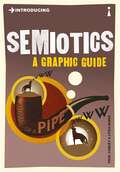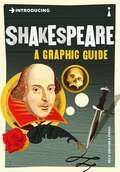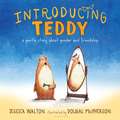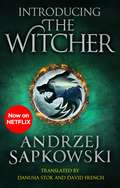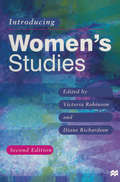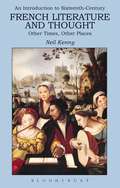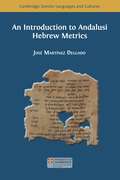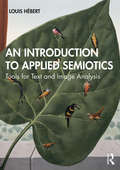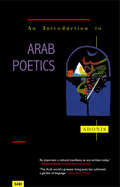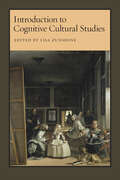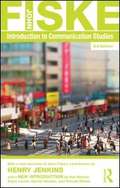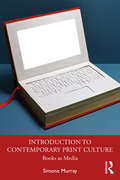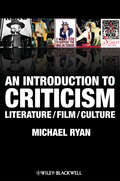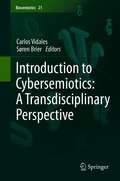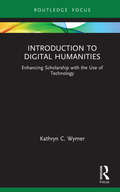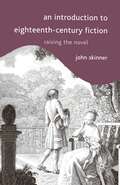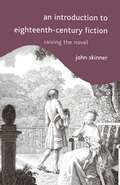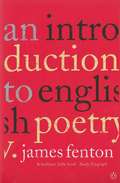- Table View
- List View
Introducing Semiotics: A Graphic Guide (Introducing... #18)
by Paul Cobley"Introducing Semiotics" outlines the development of sign study from its classical precursors to contemporary post-structuralism. Through Paul Cobley's incisive text and Litza Jansz's brilliant illustrations, it identifies the key semioticians and their work and explains the simple concepts behind difficult terms. For anybody who wishes to know why signs are crucial to human existence and how we can begin to study systems of signification, this book is the place to start.
Introducing Shakespeare: A Graphic Guide (Introducing... Ser.)
by Nick GroomShakespeare's absolute pre-eminence is simply unparalleled. His plays pack theatres and provide Hollywood with block-buster scripts; his works inspire mountains of scholarship and criticism every year. He has given us many of the very words we speak, and even some of the thoughts we think. Nick Groom and Piero explore how Shakespeare became so famous and influential, and why he is still widely considered the greatest writer ever. They investigate how the Bard has been worshipped at different times and in different places, used and abused to cultural and political ends, and the roots of intense controversies which have surrounded his work. Much more than a biography or a guide to his plays and sonnets, Introducing Shakespeare is a tour through the world of Will and concludes that even after centuries, Shakespeare remains the battlefield on which our very comprehension of humanity is being fought out.
Introducing Teddy: A gentle story about gender and friendship
by Jessica WaltonIntroducing Teddy introduces the youngest readers to understanding gender identity and transition in an accessible and heart-warming story about being true to yourself and being a good friend.Errol and his teddy, Thomas, are best friends who do everything together. Whether it's riding a bike, playing in the tree house, having a tea party, or all of the above, every day holds something fun to do. One sunny day, Errol finds that Thomas is sad, even when they are playing in their favorite ways. Errol can't figure out why, until Thomas finally tells Errol what the teddy has been afraid to say: "In my heart, I've always known that I'm a girl teddy, not a boy teddy. I wish my name was Tilly, not Thomas." And Errol says, "I don't care if you're a girl teddy or a boy teddy! What matters is that you are my friend."
Introducing Teddy: A gentle story about gender and friendship
by Jessica Walton Dougal MacPhersonIntroducing Teddy introduces the youngest readers to understanding gender identity and transition in an accessible and heart-warming story about being true to yourself and being a good friend.Errol and his teddy, Thomas, are best friends who do everything together. Whether it's riding a bike, playing in the tree house, having a tea party, or all of the above, every day holds something fun to do. One sunny day, Errol finds that Thomas is sad, even when they are playing in their favorite ways. Errol can't figure out why, until Thomas finally tells Errol what the teddy has been afraid to say: "In my heart, I've always known that I'm a girl teddy, not a boy teddy. I wish my name was Tilly, not Thomas." And Errol says, "I don't care if you're a girl teddy or a boy teddy! What matters is that you are my friend."
Introducing The Witcher: The Last Wish, Sword of Destiny and Blood of Elves (The\witcher Ser. #.5)
by Andrzej SapkowskiIntroducing Geralt the Witcher - revered and hated - who holds the line against the monsters plaguing humanity in the bestselling series that inspired the Witcher video games and a major Netflix show.Geralt of Rivia is a Witcher, a man whose magic powers and lifelong training have made him a brilliant fighter and a merciless assassin.Yet he is no ordinary killer: he hunts the vile fiends that ravage the land and attack the innocent.But not everything monstrous-looking is evil; not everything fair is good . . . and in every fairy tale there is a grain of truth.Start the epic journey now with this eBook boxset, containing the very first stories set in the witcher world, plus the opening novel to Andrzej Sapkowski's groundbreaking series.Translated by Danusia Stok.Andrzej Sapkowski, winner of the World Fantasy Lifetime Achievement award, started an international phenomenon with his Witcher series. The Last Wish is the perfect introduction to this one-of-a-kind fantasy world.
Introducing Women's Studies: Feminist theory and practice
This enlarged and fully updated edition of the best-selling Introduction to Women's Studies provides a wide-ranging and accessible overview of the main themes, issues and substantive areas in this popular. Truly interdisciplinary in its approach, it introduces the student to key ideas and debates, offering an up-to-date summary of research and a critique of important arguments. Three new chapters have been added to extend further the book's broad scope and all the chapters have been revised to take account of the latest developments in the field.
An Introduction to 16th-century French Literature and Thought: Other Times, Other Places
by Neil KennyThe age of Shakespeare, Cervantes, Erasmus, Luther, and Machiavelli produced in France too some of Europe's greatest ever literature and thought: Montaigne's Essays, Rabelais' comic fictions, Ronsard's poetry, Calvin's theology. These and numerous other extraordinary writings emerged from and contributed to cultural upheavals: the movement usually known as the Renaissance, which sought to revive ancient Greek and Roman culture for present-day purposes; religious reform, including the previously unthinkable rejection of Catholicism by many in the Reformation, culminating in decades of civil war in France; the French language's transformation into an instrument for advanced abstract thought. This book introduces this vibrant literature and thought via an apparent paradox. Most writers were profoundly concerned to improve life in the here-and-now - socially, politically, morally, spiritually. Yet they often tried to do so by making detours, in their writing, to other times and places: antiquity; heaven and hell; the hidden recesses of Nature, the cosmos, or the future; the remote location of an absent loved one; the newly 'discovered' Americas.The point was to show readers that the only way to live in the here-and-now was to connect it to larger realities - cosmic, spiritual, and historical.
An Introduction to 16th-century French Literature and Thought: Other Times, Other Places
by Neil KennyThe age of Shakespeare, Cervantes, Erasmus, Luther, and Machiavelli produced in France too some of Europe's greatest ever literature and thought: Montaigne's Essays, Rabelais' comic fictions, Ronsard's poetry, Calvin's theology. These and numerous other extraordinary writings emerged from and contributed to cultural upheavals: the movement usually known as the Renaissance, which sought to revive ancient Greek and Roman culture for present-day purposes; religious reform, including the previously unthinkable rejection of Catholicism by many in the Reformation, culminating in decades of civil war in France; the French language's transformation into an instrument for advanced abstract thought. This book introduces this vibrant literature and thought via an apparent paradox. Most writers were profoundly concerned to improve life in the here-and-now - socially, politically, morally, spiritually. Yet they often tried to do so by making detours, in their writing, to other times and places: antiquity; heaven and hell; the hidden recesses of Nature, the cosmos, or the future; the remote location of an absent loved one; the newly 'discovered' Americas.The point was to show readers that the only way to live in the here-and-now was to connect it to larger realities - cosmic, spiritual, and historical.
Introduction to a Poetics of Diversity: by Édouard Glissant (The Glissant Translation Project #1)
by Celia BrittonThis book reproduces the texts of four lectures, followed by discussions, and two interviews with Lise Gauvin published in Introduction à une poétique du divers (1996); and also four further interviews from L’Imaginaire des langues (Lise Gauvin, 2010). It covers a wide range of topics but key recurring themes are creolization, language and langage, culture and identity, ‘monolingualism’, the ‘Chaos-world’ and the role of the writer. Migration and the various different kinds of migrants are also discussed, as is the difference between ‘atavistic’ and ‘composite’ communities, the art of translation, identity as a ‘rhizome’ rather than a single root, the Chaos-World and chaos theory, ‘trace thought’ as opposed to ‘systematic thought’, the relation between ‘place’ and the Whole-World, exoticism, utopias, a new definition of beauty as the realized quantity of differences, the status of literary genres and the possibility that literature as a whole will disappear. Four of the interviews (Chapters 6, 7, 8 and 9) relate to particular works that Glissant has published: Tout-monde, Le monde incrée, La Cohée du Lamentin, Une nouvelle région du monde. Many of these themes have been explored in his previous works, but here, because in all the chapters we see Glissant interacting with the questions and views of other people, they are presented in a particularly accessible form.
An Introduction to Andalusi Hebrew Metrics: (pdf)
by José Martínez DelgadoThroughout the last two centuries, Hebrew metrics was studied by leading linguists and specialists in medieval Hebrew poetry. Nowadays, it has disappeared from the academic discussion such that it is sometimes even difficult to find scansions or the name of the meter in new editions of poems. This book aims to rectify this gap, helping readers to understand the metric structure of this poetry in order to facilitate the work of editing and cataloguing those samples still in manuscript form for future editors. Delgado presents his view of Andalusi Hebrew metrics, as encountered in medieval manuals of Arabic and Hebrew metrics and scattered notes in the works of Andalusi Hebrew philologists. Whilst twentieth-century scholars spoke about the adaptation of Arabic metrics to Hebrew, he instead approaches these compositions by Andalusi Jews (10th-13th c.) as Arabic metrics written in Hebrew, thus emphasising how Hebrew poetry of the Andalusi Jews can help us to understand the general evolution of Arabic strophic poetry, and its experimental evolution, which is quite unlike classical and strophic Arabic poetry. This method respects the Hebrew vowel system, and does not necessitate alteration of word morphology, leaving the guttural letters quiescent (unless required by metrical license); nor does it necessitate guesses about metres that are not in the classical catalogue. Although the author has not found each and every classical metre from Andalusi Hebrew poetry included in this manual, they are all catalogued, either in case someone finds them in future or because they help us to comprehend the metrical structures that are characteristic of strophic poetry. As such, this monograph will be of great interest to scholars of Hebrew metrics.
An Introduction to Applied Semiotics: Tools for Text and Image Analysis
by Louis HébertAn Introduction to Applied Semiotics presents nineteen semiotics tools for text and image analysis. Covering a variety of different schools and approaches, together with the author’s own original approach, this is a full and synthetic introduction to semiotics. This book presents general tools that can be used with any semiotic product. Drawing on the work of Fontanille, Genette, Greimas, Hébert, Jakobson, Peirce, Rastier and Zilberberg, the tools deal with the analysis of themes and action, true and false, positive and negative, rhythm narration and other elements. The application of each tool is illustrated with analyses of a wide range of texts and images, from well-known or distinctive literary texts, philosophical or religious texts or images, paintings, advertising and everyday signs and symbols. Each chapter has the same structure – summary, theory and application – and includes exercises and discussion questions, making it ideal for course use. Covering both visual and textual objects, this is a key text for all courses in semiotics and textual analysis within linguistics, communication studies, literary theory, design, marketing and related areas.
An Introduction to Applied Semiotics: Tools for Text and Image Analysis
by Louis HébertAn Introduction to Applied Semiotics presents nineteen semiotics tools for text and image analysis. Covering a variety of different schools and approaches, together with the author’s own original approach, this is a full and synthetic introduction to semiotics. This book presents general tools that can be used with any semiotic product. Drawing on the work of Fontanille, Genette, Greimas, Hébert, Jakobson, Peirce, Rastier and Zilberberg, the tools deal with the analysis of themes and action, true and false, positive and negative, rhythm narration and other elements. The application of each tool is illustrated with analyses of a wide range of texts and images, from well-known or distinctive literary texts, philosophical or religious texts or images, paintings, advertising and everyday signs and symbols. Each chapter has the same structure – summary, theory and application – and includes exercises and discussion questions, making it ideal for course use. Covering both visual and textual objects, this is a key text for all courses in semiotics and textual analysis within linguistics, communication studies, literary theory, design, marketing and related areas.
An Introduction to Arab Poeti
by AdonisPoetry is the quintessence of Arab culture. In this book, one of the foremost Arab poets reinterprets a rich and ancient heritage. He examines the oral tradition of pre-Islamic Arabian poetry, as well as the relationship between Arabic poetry and the Qur'an, and between poetry and thought. Adonis also assesses the challenges of modernism and the impact of western culture on the Arab poetic tradition. Stimulating in their originality, eloquent in their treatment of a wide range of poetry and criticism, these reflections open up fresh perspectives on one of the world's greatest - and least explored - literatures. 'The most intellectually stimulating of several Arab books of unique literary distinction in fine translations ... Translated with uncommon intelligence ... As important a cultural manifesto as any written today.' Edward Said, Independent on Sunday 'Adonis's only prose work available in English is this book. The loss is ours and it is massive, for Adonis is a writer like Neruda or Marquez.' Geoff Dyer, Independent 'Introduces the reader to a new way of interpreting all poetry, and to many marvellous words that do not have an English equivalent.' Arts Letter
Introduction to Cognitive Cultural Studies
by Lisa ZunshineDrawing on the explosion of academic and public interest in cognitive science in the past two decades, this volume features articles that combine literary and cultural analysis with insights from neuroscience, cognitive evolutionary psychology and anthropology, and cognitive linguistics. Lisa Zunshine’s introduction provides a broad overview of the field. The essays that follow are organized into four parts that explore developments in literary universals, cognitive historicism, cognitive narratology, and cognitive approaches in dialogue with other theoretical approaches, such as postcolonial studies, ecocriticism, aesthetics, and poststructuralism. Introduction to Cognitive Cultural Studies provides readers with grounding in several major areas of cognitive science, applies insights from cognitive science to cultural representations, and recognizes the cognitive approach’s commitment to seeking common ground with existing literary-theoretical paradigms. This book is ideal for graduate courses and seminars devoted to cognitive approaches to cultural studies and literary criticism.Contributors: Mary Thomas Crane, Nancy Easterlin, David Herman, Patrick Colm Hogan, Bruce McConachie, Alan Palmer, Alan Richardson, Ellen Spolsky, G. Gabrielle Starr, Blakey Vermeule, Lisa Zunshine
Introduction To Communication Studies
by John FiskeThis revised edition of a now classic text includes a new introduction by Henry Jenkins, explaining 'Why Fiske Still Matters' for today's students, followed by a discussion between former Fiske students Ron Becker, Elana Levine, Darrell Newton and Pamela Wilson on the theme of 'Structuralism and Semiotics, Fiske-Style'. Both underline the continuing relevance of this foundational text in communication studies. How can we study communication? What are the main theories and methods of approach? This classic text provides a lucid, accessible introduction to the main authorities in the field of communication studies, aimed at students coming to the subject for the first time. It outlines a range of methods of analysing examples of communication, and describes the theories underpinning them. Thus armed, the reader will be able to tease out the latent cultural meanings in such apparently simple communications as news photos or popular TV programmes, and to see them with new eyes.
Introduction to Contemporary Print Culture: Books as Media
by Simone MurrayIntroduction to Contemporary Print Culture examines the role of the book in the modern world. It considers the book’s deeply intertwined relationships with other media through ownership structures, copyright and adaptation, the constantly shifting roles of authors, publishers and readers in the digital ecosystem and the merging of print and digital technologies in contemporary understandings of the book object. Divided into three parts, the book first introduces students to various theories and methods for understanding print culture, demonstrating how the study of the book has grown out of longstanding academic disciplines. The second part surveys key sectors of the contemporary book world – from independent and alternative publishers to editors, booksellers, readers and libraries – focusing on topical debates. In the final part, digital technologies take centre stage as eBook regimes and mass-digitisation projects are examined for what they reveal about information power and access in the twenty-first century. This book provides a fascinating and informative introduction for students of all levels in publishing studies, book history, literature and English, media, communication and cultural studies, cultural sociology, librarianship and archival studies and digital humanities.
Introduction to Contemporary Print Culture: Books as Media
by Simone MurrayIntroduction to Contemporary Print Culture examines the role of the book in the modern world. It considers the book’s deeply intertwined relationships with other media through ownership structures, copyright and adaptation, the constantly shifting roles of authors, publishers and readers in the digital ecosystem and the merging of print and digital technologies in contemporary understandings of the book object. Divided into three parts, the book first introduces students to various theories and methods for understanding print culture, demonstrating how the study of the book has grown out of longstanding academic disciplines. The second part surveys key sectors of the contemporary book world – from independent and alternative publishers to editors, booksellers, readers and libraries – focusing on topical debates. In the final part, digital technologies take centre stage as eBook regimes and mass-digitisation projects are examined for what they reveal about information power and access in the twenty-first century. This book provides a fascinating and informative introduction for students of all levels in publishing studies, book history, literature and English, media, communication and cultural studies, cultural sociology, librarianship and archival studies and digital humanities.
An Introduction to Criticism: Literature - Film - Culture (Coursesmart Ser.)
by Michael RyanAn accessible and thorough introduction to literary theory and contemporary critical practice, this book is an essential resource for beginning students of literary criticism. Covers traditional approaches such as formalism and structuralism, as well as more recent developments in criticism such as evolutionary theory, cognitive studies, ethical criticism, and ecocriticism Offers explanations of key works and major ideas in literary criticism and suggests key elements to look for in a literary text Also applies critical approaches to various examples from film studies Helps students to build a critical framework and write analytically
An Introduction to Criticism: Literature - Film - Culture
by Michael RyanAn accessible and thorough introduction to literary theory and contemporary critical practice, this book is an essential resource for beginning students of literary criticism. Covers traditional approaches such as formalism and structuralism, as well as more recent developments in criticism such as evolutionary theory, cognitive studies, ethical criticism, and ecocriticism Offers explanations of key works and major ideas in literary criticism and suggests key elements to look for in a literary text Also applies critical approaches to various examples from film studies Helps students to build a critical framework and write analytically
Introduction to Cybersemiotics: A Transdisciplinary Perspective (Biosemiotics #21)
by Carlos Vidales Søren BrierThis book traces the origins and evolution of cybersemiotics, beginning with the integration of semiotics into the theoretical framework of cybernetics and information theory. The book opens with chapters that situate the roots of cybersemiotics in Peircean semiotics, describe the advent of the Information Age and cybernetics, and lay out the proposition that notions of system, communication, self-reference, information, meaning, form, autopoiesis, and self-control are of equal topical interest to semiotics and systems theory. Subsequent chapters introduce a cybersemiotic viewpoint on the capacity of arts and other practices for knowing. This suggests pathways for developing Practice as Research and practice-led research, and prompts the reader to view this new configuration in cybersemiotic terms. Other contributors discuss cultural and perceptual shifts that lead to interaction with hybrid environments such as Alexa. The relationship of storytelling and cybersemiotics is covered at chapter length, and another chapter describes an individual-collectivity dialectics, in which the latter (Commind) constrains the former (interactants), but the former fuels the latter. The concluding chapter begins with the observation that digital technologies have infiltrated every corner of the metropolis - homes, workplaces, and places of leisure - to the extent that cities and bodies have transformed into interconnected interfaces. The book challenges the reader to participate in a broader discussion of the potential, limitations, alternatives, and criticisms of cybersemiotics.
Introduction to Digital Humanities: Enhancing Scholarship with the Use of Technology (Routledge Focus on Literature)
by Kathryn C. WymerIntroduction to Digital Humanities is designed for researchers, teachers, and learners in humanities subject areas who wish to align their work with the field of digital humanities. Many institutions are encouraging digital approaches to the humanities, and this book offers guidance for students and scholars wishing to make that move by reflecting on why and when digital humanities tools might usefully be applied to engage in the kind of inquiry that is the basis for study in humanities disciplines. In other words, this book puts the "humanities" before the "digital" and offers the reader a conceptual framework for how digital projects can advance research and study in the humanities. Both established and early career humanities scholars who wish to embrace digital possibilities in their research and teaching will find insights on current approaches to the digital humanities, as well as helpful studies of successful projects.
Introduction to Digital Humanities: Enhancing Scholarship with the Use of Technology (Routledge Focus on Literature)
by Kathryn C. WymerIntroduction to Digital Humanities is designed for researchers, teachers, and learners in humanities subject areas who wish to align their work with the field of digital humanities. Many institutions are encouraging digital approaches to the humanities, and this book offers guidance for students and scholars wishing to make that move by reflecting on why and when digital humanities tools might usefully be applied to engage in the kind of inquiry that is the basis for study in humanities disciplines. In other words, this book puts the "humanities" before the "digital" and offers the reader a conceptual framework for how digital projects can advance research and study in the humanities. Both established and early career humanities scholars who wish to embrace digital possibilities in their research and teaching will find insights on current approaches to the digital humanities, as well as helpful studies of successful projects.
An Introduction to Eighteenth-Century Fiction: Raising the Novel
by John SkinnerThe formal and expressive range of canonic eighteenth-century fiction is enourmous: between them Defoe, Richardson, Fielding, Smollett and Sterne seem to have anticipated just about every question confronting the modern novelist; and Aphra Behn even raises a number of issues overlooked by her male successors. But one might also reverse the coin: much of what is present in these writers will today seem remote and bizarre. There is, in fact, only one novelist from the 'long' eighteenth century who is not an endangered species outside the protectorates of university English departments: Jane Austen. Plenty of people read her, moreover, without the need for secondary literature. These reservations were taken into account in the writing of this book.An Introduction to Eighteenth Century Fiction is a comprehensive and accessible introduction to English fiction from Aphra Behn to Jane Austen. It deals with novel criticism, canon formation and relations between genre and gender. The second part of the book contains an extensive discussion of Richardson and Fielding, followed by paired readings of major eighteenth-century novels, juxtaposing texts by Behn and Defoe, Sterne and Smollett, Lennox and Burney among others. The various sections of the book, and even the individual chapters, may be read independently or in any order. Works are discussed in a way intended to help students who have not read them, and even engage with some who never will. The author consumes eighteenth-century fiction avidly, but has tried to write a reader-friendly survey for those who may not.
An Introduction to Eighteenth-Century Fiction: Raising the Novel
by John SkinnerThe formal and expressive range of canonic eighteenth-century fiction is enourmous: between them Defoe, Richardson, Fielding, Smollett and Sterne seem to have anticipated just about every question confronting the modern novelist; and Aphra Behn even raises a number of issues overlooked by her male successors. But one might also reverse the coin: much of what is present in these writers will today seem remote and bizarre. There is, in fact, only one novelist from the 'long' eighteenth century who is not an endangered species outside the protectorates of university English departments: Jane Austen. Plenty of people read her, moreover, without the need for secondary literature. These reservations were taken into account in the writing of this book.An Introduction to Eighteenth Century Fiction is a comprehensive and accessible introduction to English fiction from Aphra Behn to Jane Austen. It deals with novel criticism, canon formation and relations between genre and gender. The second part of the book contains an extensive discussion of Richardson and Fielding, followed by paired readings of major eighteenth-century novels, juxtaposing texts by Behn and Defoe, Sterne and Smollett, Lennox and Burney among others. The various sections of the book, and even the individual chapters, may be read independently or in any order. Works are discussed in a way intended to help students who have not read them, and even engage with some who never will. The author consumes eighteenth-century fiction avidly, but has tried to write a reader-friendly survey for those who may not.
An Introduction to English Poetry
by James FentonJames Fenton's An Introduction to English Poetry offers a master class for both the reader and writer of poetry. Simply and elegantly written and discussing the work of poets as wide ranging as W. H. Auden, Dylan Thomas, Tennyson, Kipling, Milton and Blake, it covers all varieties of poetic practice in English.'It is hard to imagine a beginner who could not learn from [this book]. If you know a young poet, give them this' The Times Literary Supplement
